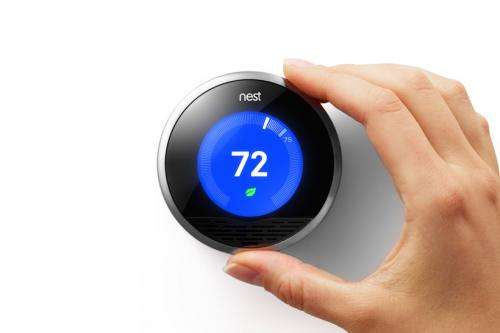August 4, 2015 report
Researchers suggest office thermostat settings biased against women

(Phys.org)—A pair of researchers with the Maastricht University Medical Center in The Netherlands has conducted a study into the comfort level of office buildings for women. In their paper published in the journal Nature Climate Change, Boris Kingma and Wouter van Marken Lichtenbelt, report that they have found that many office thermostat settings are based on an outdated formula that leaves women feeling cold in their work environment. Joost van Hoof with Fontys University discusses the study by the two in a News & Views piece in the same journal issue and concludes that formulas used to set office workspace temperatures need to be updated to include the needs of not just women, but people of different weights and ages.
Anybody who has worked in an office environment in the summer, in a large building knows that many of the women that work in such places find it too cold for comfort. Sweaters are not uncommon, despite high temperatures outside. The reason for this, Kingma and Lichtenbelt assert, is because the formula used to calculate HVAC settings (predicted mean vote or PMV) is based on a study conducted in the mid-sixties that used mostly middle age men as test subjects. To prove their point, they enlisted the assistance of 16 young women to volunteer to be tested for air comfort levels in a special chamber that allowed for monitoring respiration—oxygen taken in and carbon dioxide emitted—along with measuring skin and internal core temperatures. The women wore t-shirts and sweat pants and were asked to engage in common office activities such as typing emails or talking. In analyzing their results, they found that the average metabolic rate for the women was approximately 20 to 32 percent lower than the rates that are typically used when cooling office buildings in the summer. Turning up the temperature would not only make things more comfortable for women, they note, but would also reduce cooling bills and greenhouse gas emissions.
The sample size is of course too small, as van Hoof points out, to draw any real conclusions, but it does offer some credence to back up anecdotal evidence of too cold workplaces for many women and suggests a revision of the standards using in calculating office environments is in order. In practice, the margin of change might be small—the research duo suggest women may prefer temperatures close to 75F°, while men prefer it to be closer to 70. Perhaps building supervisors could split the difference and set it at 72.5.
More information: Energy consumption in buildings and female thermal demand, Nature Climate Change (2015) DOI: 10.1038/nclimate2741
Abstract
Energy consumption of residential buildings and offices adds up to about 30% of total carbon dioxide emissions; and occupant behaviour contributes to 80% of the variation in energy consumption1. Indoor climate regulations are based on an empirical thermal comfort model that was developed in the 1960s (ref. 2). Standard values for one of its primary variables—metabolic rate—are based on an average male, and may overestimate female metabolic rate by up to 35% (ref. 3). This may cause buildings to be intrinsically non-energy-efficient in providing comfort to females. Therefore, we make a case to use actual metabolic rates. Moreover, with a biophysical analysis we illustrate the effect of miscalculating metabolic rate on female thermal demand. The approach is fundamentally different from current empirical thermal comfort models and builds up predictions from the physical and physiological constraints, rather than statistical association to thermal comfort. It provides a substantiation of the thermal comfort standard on the population level and adds flexibility to predict thermal demand of subpopulations and individuals. Ultimately, an accurate representation of thermal demand of all occupants leads to actual energy consumption predictions and real energy savings of buildings that are designed and operated by the buildings services community.
Journal information: Nature Climate Change
© 2015 Phys.org

















